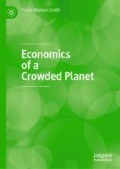Abstract
This chapter introduces an economics of a crowded planet as the study of a materially large economy coevolving with nature and as the engine of economic policy. It discusses whether resources for the economy are limited, a source of great misunderstanding between natural scientists and economists. It argues that, on a crowded planet, the primary purpose of economics is not the study of individual choice, as the introductory textbooks claim, but to understand how to align the economy with nature, using such institutions at our disposal as the market and government regulation. This chapter outlines the rest of the book and defines terms.
Access this chapter
Tax calculation will be finalised at checkout
Purchases are for personal use only
Notes
- 1.
Diamond (1991).
- 2.
Scientists consider the ‘Anthropocene’ to begin following the end of the last ice age about ten thousand years ago (Kolbert 2014, pp. 107–110), even though it has only recently reached its full manifestation. At the time of writing, the term has yet to be officially adopted.
- 3.
Robbins (1932, p. 15).
- 4.
- 5.
Georgescu-Roegen (1971, pp. 318–319).
- 6.
Costanza (2010).
- 7.
Marglin (2008, p. 281).
- 8.
Hill and Myatt (2010, p. 6).
- 9.
Marglin (2008, p. 247).
- 10.
Marglin (2008, p. 167).
- 11.
An ontology is a statement about what exists.
- 12.
- 13.
See, for example, in Smith (1997). The term in fact term can be found as far back as Meadows et al.’s Limits to Growth in 1972. The computer model Donella Meadows and others developed to simulate interactions among natural and social factors was used to find “a model output that represents a world system that is … sustainable without sudden and uncontrollable collapse…” (Meadows et al. 1972, p. 164). That same year, Goldsmith et al.’s Blueprint for Survival argued that “the principal defect of the industrial way of life, with its ethos of expansion, is that it is not sustainable” (Goldsmith et al. 1972, p. 3).
- 14.
In fact, the ecological economists Robert Costanza and Bernard Patten did exactly this. “A sustainable system,” they wrote, “is one which survives or persists” (Costanza and Patten 1995, p. 193). Similarly, Costanza and Folke (1996, p. 19) defined ‘sustainability’ as being associated with longevity.
- 15.
Worster (1995, p. 424).
- 16.
Sachs (1995, p. 434).
- 17.
Worster (1995, p. 425).
- 18.
- 19.
Schmidheiny and Zorraquín (1996, p. 99).
- 20.
Sachs (1995, pp. 434–436).
- 21.
Worster (1995, p. 426).
- 22.
Naess (1995, p. 464).
- 23.
John Garn, pers. comm.
References
Boulding, K.E. 1966. The Economics of the Coming Spaceship Earth. In Environmental Quality in a Growing Economy, ed. H. Jarrett, 3–14. Baltimore, MD: John Hopkins Press.
Costanza, R. 2010. Flourishing on Earth: Lessons from Ecological Economics. Lecture Given at Yale University, June 24. https://www.youtube.com/watch?v=PZkTlVPgqG4.
Costanza, R., and C. Folke. 1996. The Structure and Function of Ecological Systems. In Rights to Nature, ed. S.S. Hanna, C. Folke, and K.-G. Mäler, 13–34. Washington, DC: Island Press.
Costanza, R., and B. Patten. 1995. Defining and Predicting Sustainability. Ecological Economics 15: 193–196.
Daly, H.E. 1991. Steady-State Economics, 2nd ed. New York: Wiley.
Diamond, J. 1991. The Rise and Fall of the Third Chimpanzee. London: Hutchinson Radius.
Galbraith, J.K. 1973. Economics and the Public Purpose. Boston, MA: Houghton Mifflin.
Georgescu-Roegen, N. 1971. The Entropy Law and the Economic Process. Cambridge: Harvard University Press.
Goldsmith, E., et al. 1972. Blueprint for Survival. New York: Signet, New American Library, Inc.
Hill, R., and T. Myatt. 2010. The Economics Anti-Textbook: A Critical Thinker’s Guide to Microeconomics. London: Zed Books.
Kolbert, E. 2014. The Sixth Extinction: An Unnatural History. New York: Picador, Henry Holt & Company.
Marglin, S. 2008. The Dismal Science: How Thinking Like an Economist Undermines Community. Cambridge: Harvard University Press.
Meadows, D.H., et al. 1972. The Limits to Growth: A Report for the Club of Rome’s Project on the Predicament of Mankind. New York: Universe Books.
Naess, A. 1995. Deep Ecology for the Twenty-Second Century. In Deep Ecology for the 21st Century: Readings on the Philosophy and Practice of the New Environmentalism, ed. G. Sessions, 463–468. Boston and London: Shambhala.
Robbins, L. 1932. The Nature and Significance of Economic Science. London: Macmillan.
Sachs, W. 1995. Global Ecology and the Shadow of ‘Development’. In Deep Ecology for the 21st Century: Readings on the Philosophy and Practice of the New Environmentalism, ed. G. Sessions, 428–444. Boston and London: Shambhala.
Samuelson, P. 1970. Economics, 8th ed. New York: McGraw-Hill.
Schmidheiny, S., and F.J. Zorraquín. 1996. Financing Change: The Financial Community, Eco-Efficiency and Sustainable Development. With World Business Council for Sustainable Development. Cambridge, MA: MIT Press.
Smith, F.D.M. (ed.). 1997. Environmental Sustainability: Practical Global Implications. St. Lucie Press: Baton Rouge, FL.
United Nations. 1992. Report of the United Nations Conference on Environment and Development, Rio De Janeiro, Annex I: Rio Declaration on Environment and Development. New York: United Nations.
World Commission on Environment and Development. 1987. Our Common Future. New York: Oxford University Press.
Worster, D. 1995. The Shaky Ground of Sustainability. In Deep Ecology for the 21st Century: Readings on the Philosophy and Practice of the New Environmentalism, ed. G. Sessions, 417–427. Boston and London: Shambhala.
Author information
Authors and Affiliations
Rights and permissions
Copyright information
© 2019 The Author(s)
About this chapter
Cite this chapter
Murison Smith, F. (2019). Introduction. In: Economics of a Crowded Planet. Palgrave Macmillan, Cham. https://doi.org/10.1007/978-3-030-31798-0_1
Download citation
DOI: https://doi.org/10.1007/978-3-030-31798-0_1
Published:
Publisher Name: Palgrave Macmillan, Cham
Print ISBN: 978-3-030-31797-3
Online ISBN: 978-3-030-31798-0
eBook Packages: Economics and FinanceEconomics and Finance (R0)

